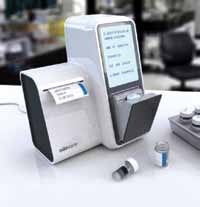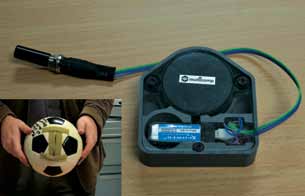It has priced the laptop economically hoping to promote the segment. If successful, the company hopes to build a subsequent version with satellite connectivity—another feature that will be very useful in rural areas that do not have proper landline infrastructure.
What’s inside: Sol runs on a four-panel solar-charging device built into the computer’s case. It takes approximately two hours to charge the laptop’s battery, which then lasts for about eight to ten hours. The laptop can run off the solar panels directly when exposed to sunlight, bypassing the battery. Although the computer is slightly heavier than today’s laptops, it is still not too tough to carry and fits into most laptop bags. The device is sturdy and robust, with rubber lining on the sides and a thick outer shell. The solar panels are housed inside a case on the back of the screen lid, and are not noticeable when folded up. The devices will come with a 250GB hard drive and 4GB memory, as well as a suite of free office and accounting software.
Web: http://mobile.solaptop.com
Device that detects bladder cancer
 Several studies published in the last decade have suggested that chemicals/metabolite levels visible in our breath can indicate the risks for diseases such as stomach cancer and heart failure, and that the scent of gases in urine could be used to test for bladder cancer. Building on such findings and their earlier attempts at building an electronic nose, a team from the University of Liverpool and the University of the West of England (Bristol) recently disclosed a new invention, the Odoreader. The device uses sensors to sniff out the chemicals in urine and delivers an accurate bladder cancer diagnosis within 30 minutes.
Several studies published in the last decade have suggested that chemicals/metabolite levels visible in our breath can indicate the risks for diseases such as stomach cancer and heart failure, and that the scent of gases in urine could be used to test for bladder cancer. Building on such findings and their earlier attempts at building an electronic nose, a team from the University of Liverpool and the University of the West of England (Bristol) recently disclosed a new invention, the Odoreader. The device uses sensors to sniff out the chemicals in urine and delivers an accurate bladder cancer diagnosis within 30 minutes.
What’s inside: The Odoreader is a volatile organic compound (VOC) sensor, which detects chemicals in gases present. The team trained it to look for the relevant chemicals using 98 different urine samples. It was then tested using samples from 24 patients suffering from bladder cancer, and 74 samples from those with other non-cancerous bladder problems. Using just nine biomarkers, the system correctly diagnosed all the cancer patients and 70 out of 74 cases where cancer was not present. The results are very promising, but the 6 per cent error rate is yet to be overcome.
In a paper on Odoreader published in PLOS One (www.plosone.org), the authors mention that “the small sample size does not allow a proper statistical assessment of the effects of other confounding factors such as smoking status, drug treatments, ethnicity.” Hence the researchers plan to work on larger samples to test the device further before it can be used in hospitals.
Web: http://news.liv.ac.uk/2013/07/09/scent-device-could-help-detect-bladder-cancer

Paper planes to help fight forest fires
Dr Paul Pounds and a team of roboticists at the University of Queensland have designed two disposable, self-steering drones with sensor modules that can be dropped over forested areas to help monitor forest fires. One, called the Polyplane, looks like a paper plane, while the other, the Samara, mimics the maple seed. Both are made of biodegradable cellulose material. Both drones are self-deploying sensor modules that can relay back environmental conditions in difficult terrain. Dozens of them can be dropped across forested areas, to report back on atmospheric conditions that could indicate the start or movements of a bushfire—one of the biggest dangers lurking in Australian forests.
What’s inside: Both drones are made of biodegradable cellulose material, and contain sensor modules. Once deployed from a larger aircraft, the Polyplane drone steers itself using tabs attached to the back of each wing. An on-board control system bends each tab to direct the craft as close as possible to a pre-determined landing area. Because the circuits can be ink-jet printed directly into the paper-like material, key components can be glued, instead of being soldered, onto the lightweight, foldable circuit board.
The Samara, designed like a maple seed, has an antenna-equipped circuit board attached to the ‘seed’ part of the helicopter blade. It cannot be steered, but the design with flexible wings allows the sensor module to float gently to the ground, thus leaving the electronics unharmed and eliminating the need for expensive landing systems.
There are several do-it-yourself drone kits available today, enabling students and hobbyists to develop unmanned aerial vehicles for various non-war purposes—you could try your own too!
Web: http://robotics.itee.uq.edu.au/wiki/pmwiki.php?n=Site.Research






